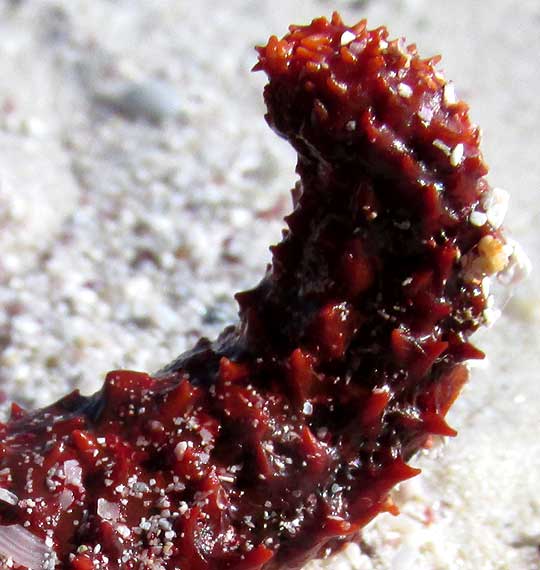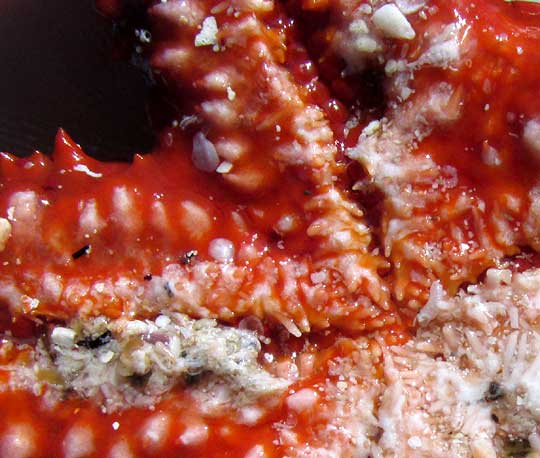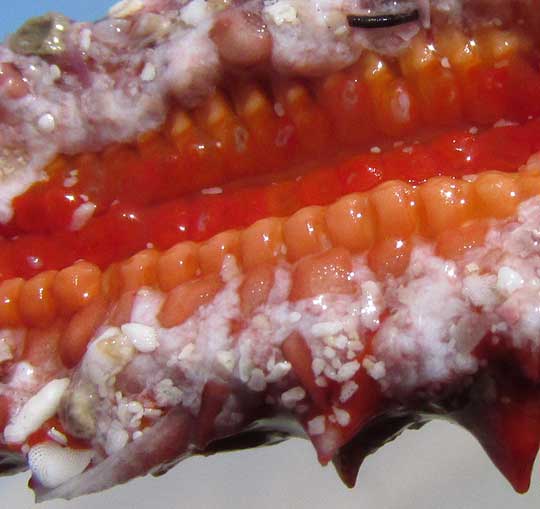Excerpts from Jim Conrad's
Naturalist Newsletter

from the February 8, 2015 Newsletter issued from Río Lagartos, on the Yucatan Peninsula's northern coast (~N21.60°, ~W88.16°), Yucatán state, MÉXICO
SPINY SEA STAR
At low tide a little red starfish only about three inches across (75mm) had been tossed ashore and either was dead on close to it. That's the creature above.
Besides being dark red, a conspicuous field mark of this species is its covering of short, broad-based spines, shown close-up below:

Underneath, the mouth that's always present in a starfish's center, was all closed up, as seen below:

An even closer look at the bottom of one of the arms, however, shows some interesting details, below:

Here on an arm's bottom surface the channel down the middle is called the "ambulacral groove." In this groove the starfish's sucker-equipped tube feet, or "podia," extend outward and coordinate into wavelike motions to pass food to the oral mouth at the body's center, plus they can attach to surfaces such as rocks. Some of the podia at the image's left corner are beginning to extend.
On both sides of the ambulacral groove are lines of toothlike "ambulacral ossicles." The word "ossicle" means "little bone," and that's what they are, just bony, smooth-topped, little nubbins. One can imagine how when the podia between the lines of ossicles pass food toward the mouth, the smooth, elevated ossicles keep the food raised above the starfish's surrounding rough skin, keeping the food from dragging or catching on it.
When a Google image search on starfish found in the Yucatan is made, many pictures of another red species turn up, the apparently abundant, similarly red and similarly spiky scaled Red Cushion Sea Star, Oreaster reticulatus. However, that starfish has thicker arms, its top scales are arranged into scale patterns, and is larger.
Our stranded starfish is ECHINASTER SENTUS, sometimes called the Spiny Sea Star. It's found in shallow waters of a variety of habitats from Florida south through the Gulf of Mexico and Caribbean to Honduras. I've seen it described as the most commonly found starfish on southern Florida's beaches.
This is my first attempt to identify a starfish and I learned a good bit doing it. During my Google-enable orientation I learned that taxonomically a starfish is a member of the echinoderm Class Asteroidea, of which about 1,500 species are known worldwide. In waters off the coast of Yucatán state about 32 starfish species have been identified.
What's the difference between a starfish and a sea star? None, except that in the old days we called them starfish but now a certain section of humanity, pointing out that they're not fish, urge everyone else to call them sea stars instead.